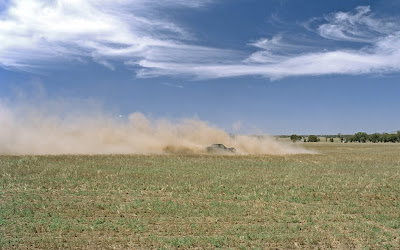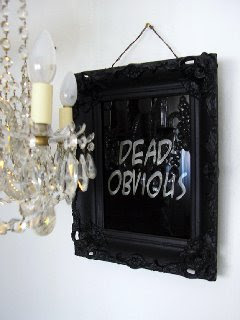Richard Malloy’s head is covered in clay. You can see his teeth behind the moist skein, an image disturbingly reminiscent of Buffalo Bill in Silence of The Lambs. Malloy’s work – on show at Gallery 9 until the end of the month – is a simple suite of four photographs and a video. You’d be no doubt thinking, oh man, not another performance video work, and you’d be right – it is. Malloy stands against a blank background in mid shot, daubing big, gooey blobs of clay onto his face, attempting to add new features. He labours for a long time trying to construct an elephant-like trunk, and later, meld his arm into his torso. The way to watch this piece is to not look at it – look at the framed pictures and think about the creation myths of humans rising from slime, the creepy CSI-like suggestions of facial reconstruction, or perhaps of bodies being excavated from shallow graves… and then move right along. For a field as crowded as body art and performance video, it’s refreshing to see something that demands your attention, and then rewards the effort.
The work in the next room is a bit of a salve after Malloy’s freak show. Grant Beran’s drawings aren’t all that surprising in their style, but they’re very good. Drawing on silver gelatine paper with ink and graphite, Beran’s pictures are scribbly and loose and the way he follows a line reminds you of, ahem, Salvador Dali and Saul Steinberg, two names that don’t get thrown around much these days. Beran himself cites an interesting cocktail of names U-Turn is after Bellini and McMahon, Infobaker is after Max Dupain and Late Night at the Natural History Museum is delightfully after Laurence Aberhart. As Inspector “Dirty” Harry Callaghan remarked at the end of Magnum Force, “Man’s got know his limitations”, so it’s pleasing to see Beran shooting for the stars.
Craig Bender, Repeating Patterns In Nature (circlework#02), 2009.
Type C photograph, 127×194 cms.
The trip to Gallery 9 was to see Craig Bender’s Repeating Patterns in Nature. Looking at Bender’s work over the last couple of shows has been interesting insight into an artist’s creative progression. The Australian landscape is such a bastard to deal with since it’s all God and rocks. Making art out of it is tricky. An exhibition at Canberra Contemporary Art Space featured work by an artist who had taken photos of Cheviot Beach, the place where Prime Minister Harold Holt drowned [or swam out to meet a waiting Chinese submarine, depending on which version you prefer to believe]. The pictures were completely benign photos of the seaside. According to the artist’s statement it was all about creating interpretation by overlaying what was an otherwise unremarkable sequence of images of a beach with the viewer’s knowledge of the place’s history.
Bender’s past work has ventured along this line of inquiry, with his sequence of images of Belanglo Forest , and while Bender made a better fist of the idea by including small details in his large photos such as small memorial crosses, there was the persistent problem of disappearance. It’s all very well highlighting the interpretative process, but you wonder how this is any different to most pictures. One almost has sympathy for the misguided opinions of people like Christopher Allen who, in his recent review of the Andreas Gursky show for The Australian, made the claim that the further that photography gets away from “truth” [by which he probably means reportage] the less valuable it is. Nah. What we want is for the photographer’s work to be seen to be telling us something, and hopefully to do it with a degree of subtlety. For Bender’s show there are just two big images, one is of a car doing circle work in a field, while on the other wall there’s a giant time lapse photograph of stars leaving circular light trails. The dialogue between these images is simplicity itself, but a fractal kind of simplicity where the micro is reflected in the macro. That it should come in the context of something so quotidian makes it all the more delightful.
Clinton Garofano, untitled : (dead obvious), 2006.
Installation detail. Reverse painting on glass, antique frames.
Clinton Garafano’s show Another Nail in the Coffin at MOP makes a virtue out of a similar sort of plain speaking. Framed in elaborate Black Forest style are two word phrases rendered in spooky, horror movie text: DEAD BORING, DEAD WRONG, DEAD CENTRE, DEAD MEAT, and so on. With weak illumination from individual light sources, the words appear wraith like, a bit like a joke, perhaps even serious. Death stalks the land in the words we speak, says the artist. Fuck me dead.
Garafano’s stated aim is to “explore and the limits and possibilities of written language” and the limits are reached fairly quickly, beyond which is realm of aesthetic regard. The installation of the work is really rather beautiful with nothing extra or unneeded. It is Zen in its simplicity, which is a nice push ‘n’ pull with the Gothic detail of the frames and white on black lettering. Where does this approach come from? Maybe it has something to do with Garafano’s vintage, being in his mid 40s and recently divorced from his long-time commercial dealer, or maybe it’s the Buddhist influence talking, but whatever it is, death comes in a very attractive package. When you compare this installation to the show running in the front room, you see the generational attitude and experience at work.
The front room of MOP is occupied by Sean Rafferty’s Ghost Mountain. Where Garafano’s work is careful and precise, Rafferty’s big installation seems positively maximal, letting all the connections hang loose in a very literal way. The first thing you see of Rafferty’s work is a wall made out of cardboard with little notes, photocopies, photographs and plan drawings of the installation stuck here and there. The impression is that the whole thing is schematic, planned, but ad hoc. This is my process, says the artist. Feel me? Stepping inside the room there are three screens. This being a gallery you’re half expecting a DVD projection, but as your eyes adjust you see that two screens are in fact photographs drawings of a mountain in negative, mounted upside down. Then there’s a screen with an image of a mountain as seen from the front garden of a house somewhere. And the image fades up to the sound of passing traffic, and then fades down again. Repeat. The work has the nagging insistence of a dream, with plenty of suggestion, but not much in the way of definitive explanation. We feel you.


